Shadow
A shadow is a dark (real image) area where light from a light source is blocked by an opaque object. It occupies all of the three-dimensional volume behind an object with light in front of it. The cross section of a shadow is a two-dimensional silhouette, or a reverse projection of the object blocking the light.

Point and non-point light sources
A point source of light casts only a simple shadow, called an "umbra". For a non-point or "extended" source of light, the shadow is divided into the umbra, penumbra and antumbra. The wider the light source, the more blurred the shadow becomes. If two penumbras overlap, the shadows appear to attract and merge. This is known as the shadow blister effect.
The outlines of the shadow zones can be found by tracing the rays of light emitted by the outermost regions of the extended light source. The umbra region does not receive any direct light from any part of the light source, and is the darkest. A viewer located in the umbra region cannot directly see any part of the light source.
By contrast, the penumbra is illuminated by some parts of the light source, giving it an intermediate level of light intensity. A viewer located in the penumbra region will see the light source, but it is partially blocked by the object casting the shadow.
If there is more than one light source, there will be several shadows, with the overlapping parts darker, and various combinations of brightnesses or even colors. The more diffuse the lighting is, the softer and more indistinct the shadow outlines become, until they disappear. The lighting of an overcast sky produces few visible shadows.
The absence of diffusing atmospheric effects in the vacuum of outer space produces shadows that are stark and sharply delineated by high-contrast boundaries between light and dark.
For a person or object touching the surface where the shadow is projected (e.g. a person standing on the ground, or a pole in the ground) the shadows converge at the point of contact.
A shadow shows, apart from distortion, the same image as the silhouette when looking at the object from the sun-side, hence the mirror image of the silhouette seen from the other side.
Astronomy
The names umbra, penumbra and antumbra are often used for the shadows cast by astronomical objects, though they are sometimes used to describe levels of darkness, such as in sunspots. An astronomical object casts human-visible shadows when its apparent magnitude is equal or lower than -4.[2] The only astronomical objects able to project visible shadows onto Earth are the Sun, the Moon, and in the right conditions, Venus or Jupiter.[3] Night is caused by the hemisphere of a planet facing its orbital star blocking its sunlight.
A shadow cast by the Earth onto the Moon is a lunar eclipse. Conversely, a shadow cast by the Moon onto the Earth is a solar eclipse.[4]
Daytime variation
The sun casts shadows which change dramatically through the day. The length of a shadow cast on the ground is proportional to the cotangent of the sun's elevation angle—its angle θ relative to the horizon. Near sunrise and sunset, when θ = 0° and cot(θ) = ∞, shadows can be extremely long. If the sun passes directly overhead (only possible in locations between the Tropics of Cancer and Capricorn), then θ = 90°, cot(θ) = 0, and shadows are cast directly underneath objects.
Such variations have long aided travellers during their travels, especially in barren regions such as the Arabian Desert.[5]
Propagation speed
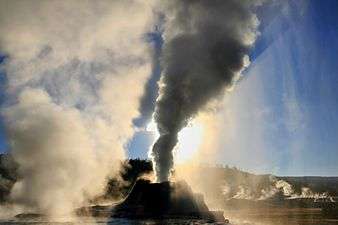
The farther the distance from the object blocking the light to the surface of projection, the larger the silhouette (they are considered proportional). Also, if the object is moving, the shadow cast by the object will project an image with dimensions (length) expanding proportionally faster than the object's own rate of movement. The increase of size and movement is also true if the distance between the object of interference and the light source are closer. This, however, does not mean the shadow may move faster than light, even when projected at vast distances, such as light years. The loss of light, which projects the shadow, will move towards the surface of projection at light speed.
Although the edge of a shadow appears to "move" along a wall, in actuality the increase of a shadow's length is part of a new projection which propagates at the speed of light from the object of interference. Since there is no actual communication between points in a shadow (except for reflection or interference of light, at the speed of light), a shadow that projects over a surface of large distances (light years) cannot convey information between those distances with the shadow's edge.[6]
Color
Visual artists are usually very aware of colored light emitted or reflected from several sources, which can generate complex multicolored shadows. Chiaroscuro, sfumato, and silhouette are examples of artistic techniques which make deliberate use of shadow effects.
During the daytime, a shadow cast by an opaque object illuminated by sunlight has a bluish tinge. This happens because of Rayleigh scattering, the same property that causes the sky to appear blue. The opaque object is able to block the light of the sun, but not the ambient light of the sky which is blue as the atmosphere molecules scatter blue light more effectively. As a result, the shadow appears bluish.[7]
Three-dimensional shadows
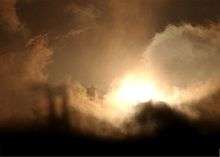
A shadow occupies a three-dimensional volume of space, but this is usually not visible until it projects onto a reflective surface. A light fog, mist, or dust cloud can reveal the 3D presence of volumetric patterns in light and shadow.
Fog shadows may look odd to viewers who are not used to seeing shadows in three dimensions. A thin fog is just dense enough to be illuminated by the light that passes through the gaps in a structure or in a tree. As a result, the path of an object's shadow through the fog becomes visible as a darkened volume. In a sense, these shadow lanes are the inverse of crepuscular rays caused by beams of light, but caused by the shadows of solid objects.
Theatrical fog and strong beams of light are sometimes used by lighting designers and visual artists who seek to highlight three-dimensional aspects of their work.
Shadow inversions
Oftentimes shadows of chain-linked fences and other such objects become inverted (light and dark areas are swapped) as they get farther from the object. A chain-link fence shadow will start with light diamonds and shadow outlines when it is touching the fence, but it will gradually blur. Eventually, if the fence is tall enough, the light pattern will go to shadow diamonds and light outlines.
Photography

In photography, which is essentially recording patterns of light, shade, and color, "highlights" and "shadows" are the brightest and darkest parts, respectively, of a scene or image. Photographic exposure must be adjusted (unless special effects are wanted) to allow the film or sensor, which has limited dynamic range, to record detail in the highlights without them being washed out, and in the shadows without their becoming undifferentiated black areas.
On satellite imagery and aerial photographs, taken vertically, tall buildings can be recognized as such by their long shadows (if the photographs are not taken in the tropics around noon), while these also show more of the shape of these buildings.
Analogous concepts
Shadow as a term is often used for any occlusion or blockage, not just those with respect to light. For example, a rain shadow is a dry area, which with respect to the prevailing wind direction, is beyond a mountain range; the elevated terrain impedes rainclouds from entering the dry zone. An acoustic shadow occurs when direct sound has been blocked or diverted around a given area.
Cultural aspects
An unattended shade was thought by some cultures to be similar to that of a ghost. The name for the fear of shadows is "sciophobia" or "sciaphobia".
Chhaya is the Hindu goddess of shadows.
In heraldry, when a charge is supposedly shown "in shadow" (the appearance is of the charge merely being outlined in a neutral tint rather than being of one or more tinctures different from the field on which it is placed), it is technically described as "umbrated". Supposedly, only a limited number of specific charges can be so depicted.
Energy generating
Scientists from the National University of Singapore presented a shadow-effect energy generator (SEG), which consists of cells of gold deposited on a silicon wafer attached on a plastic film. The generator has a power density of 0.14 μW cm−2 under indoor conditions (0.001 sun).[8]
Gallery
 Non-diffuse lighting in outer space causes deep shadows
Non-diffuse lighting in outer space causes deep shadows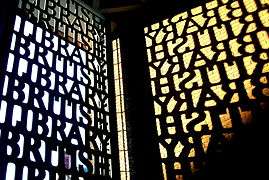 Reversed text in shadow
Reversed text in shadow Sutro Tower casts a 3D fog shadow
Sutro Tower casts a 3D fog shadow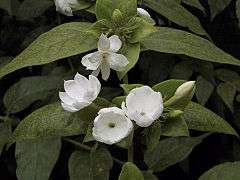 This photo of jasmine flowers has only soft shadows cast by diffused light
This photo of jasmine flowers has only soft shadows cast by diffused light Clouds and shadows over the Mediterranean Sea
Clouds and shadows over the Mediterranean Sea Shadow cast by vapour trail of passing aircraft
Shadow cast by vapour trail of passing aircraft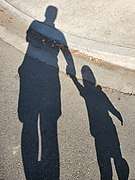 Shadow of a parent and child
Shadow of a parent and child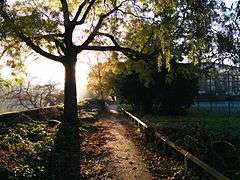 Tree shadow
Tree shadow.jpg) Shadow on the Castle
Shadow on the Castle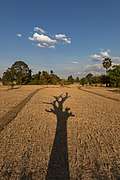 Long shadow of a dead tree with its branches on dry fields, late afternoon
Long shadow of a dead tree with its branches on dry fields, late afternoon When the sun is low, shadows become long, and details get the wrong proportions.
When the sun is low, shadows become long, and details get the wrong proportions.
See also
| Wikimedia Commons has media related to Shadow. |
- Convolution applications, for more physical and mathematical discussion about shadows
- Earth's shadow
- Gnomon
- Shade
- Shadow Cabinet
- Shadow mapping, in computer 3D graphics
- Shadow people
- Shadow play
- Shadowgraphy or ombromanie, the art of hand shadows
- Sciography, the art of architectural shadows
- Shadows in camouflage
References
- "March of the moons". Archived from the original on 28 July 2015. Retrieved 24 June 2015.
- NASA Science Question of the Week. Gsfc.nasa.gov (April 7, 2006). Retrieved on 2013-04-26.
- "Young astronomer captures a shadow cast by Jupiter : Bad Astronomy". Blogs.discovermagazine.com. 2011-11-18. Archived from the original on 2013-07-02. Retrieved 2013-05-27.
- "Lunar Eclipse vs Solar Eclipse". www.moonconnection.com. Retrieved 2019-11-27.
- The Edinburgh monthly review. 1820. p. 372.
- Philip Gibbs (1997) Is Faster-Than-Light Travel or Communication Possible? Archived 2009-11-17 at WebCite math.ucr.edu
- Question Board – Questions about Light. Pa.uky.edu. Retrieved on 2013-04-26.
- Qian Zhang; et al. (2020). "Energy harvesting from shadow-effect". Energy & Environmental Science. doi:10.1039/D0EE00825G.

